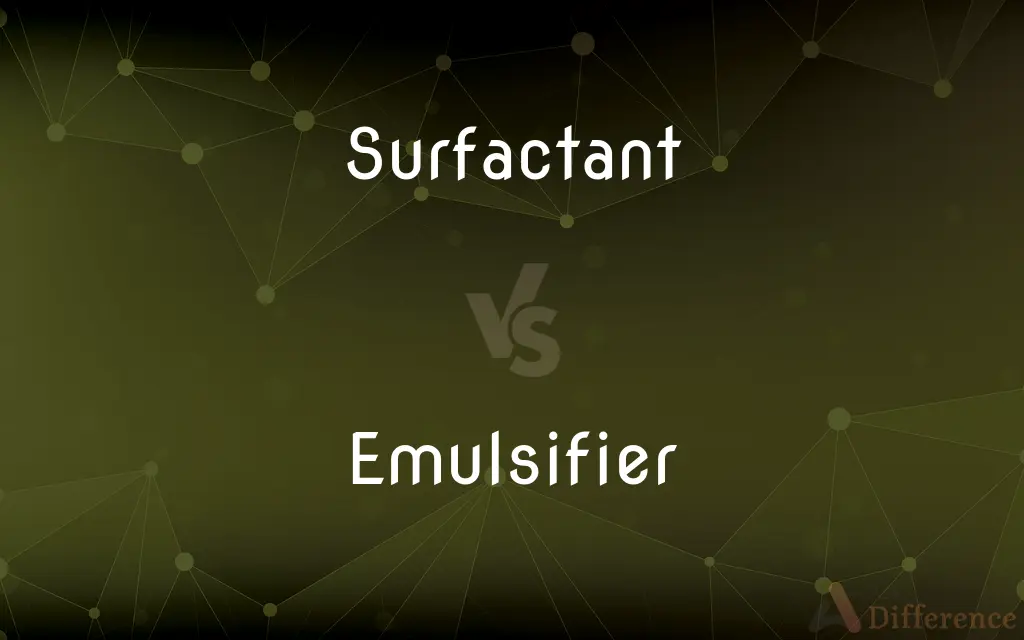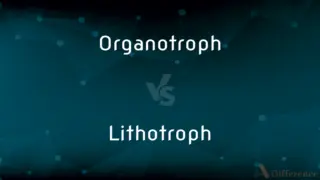Surfactant vs. Emulsifier — What's the Difference?
By Tayyaba Rehman & Fiza Rafique — Updated on April 2, 2024
Surfactants reduce surface tension between two liquids or a liquid and a solid, aiding in the mixing of substances. Emulsifiers specifically stabilize mixtures of oil and water by preventing separation.

Difference Between Surfactant and Emulsifier
Table of Contents
ADVERTISEMENT
Key Differences
Surfactants function by lowering the surface tension between two substances, like oil and water, making them easier to mix. This property is crucial in various applications, from cleaning products to pharmaceuticals, where mixing otherwise incompatible substances is necessary. On the other hand, emulsifiers are a subset of surfactants that specifically target the mixing of oil and water. They work by forming a protective barrier around oil droplets, preventing them from coalescing and thus stabilizing the mixture.
Surfactants have a wide range of uses beyond emulsifying, including reducing the surface tension of water to improve wetting and spreading properties, which is essential in detergents and herbicides. Emulsifiers, whereas, are primarily used in food production, cosmetics, and pharmaceuticals to create stable emulsions, ensuring that oil-based and water-based ingredients do not separate over time.
The effectiveness of surfactants is determined by their ability to accumulate at the interface of two phases, significantly altering interfacial properties. This capability allows them to act as detergents, wetting agents, foaming or defoaming agents, and dispersants. Emulsifiers, on the other hand, are evaluated based on their ability to form and maintain a stable emulsion, which depends on the balance of hydrophilic and lipophilic properties in their molecular structure.
While surfactants can be used in a broad spectrum of applications due to their diverse functionalities, emulsifiers are specifically chosen for tasks that require the stable mixing of oil and water phases. The choice between a surfactant and an emulsifier depends on the desired outcome of the application, whether it is to clean, to wet, to disperse, or to emulsify.
In the industrial and consumer products sectors, surfactants play a pivotal role in formulating products with desired properties such as solubility, conditioning, and texture enhancement. Emulsifiers, whereas, are key in food science for improving product stability, texture, and mouthfeel, as well as in cosmetics for creating creams and lotions with uniform consistency.
ADVERTISEMENT
Comparison Chart
Primary Function
Reduces surface tension to aid in mixing substances
Stabilizes mixtures of oil and water
Applications
Detergents, wetting agents, dispersants
Food production, cosmetics, pharmaceuticals
Action Mechanism
Accumulates at the interface of two phases, altering interfacial properties
Forms protective barrier around oil droplets to prevent coalescence
Key Properties
Diverse functionalities including cleaning, wetting, dispersing
Balance of hydrophilic and lipophilic properties for stable emulsions
Use Cases
Broad spectrum of industrial and consumer products
Specifically chosen for stable mixing of oil and water phases
Compare with Definitions
Surfactant
They are utilized in pharmaceuticals to improve the solubility of drugs.
Surfactants in inhalers help distribute medication more evenly in the lungs.
Emulsifier
Emulsifiers stabilize mixtures of oil and water by preventing the phases from separating.
Mayonnaise uses emulsifiers to maintain its creamy texture.
Surfactant
Surfactants can also function as foaming or defoaming agents in various products.
Shampoos use surfactants to create foam for cleaning hair.
Emulsifier
They are used in baking to improve texture and extend shelf life of bread and cakes.
Bread uses emulsifiers to stay soft and fresh longer.
Surfactant
Surfactants are agents that reduce surface tension between two liquids or a liquid and a solid, enhancing mixing.
Detergents contain surfactants to remove oil and dirt from clothing.
Emulsifier
They are crucial in food production for improving product consistency.
Emulsifiers in ice cream prevent ice crystal formation, ensuring smoothness.
Surfactant
In industrial applications, surfactants serve as dispersants to evenly distribute particles in a liquid.
Paints use surfactants to ensure even pigment distribution.
Emulsifier
In cosmetics, emulsifiers help to blend water and oil-based ingredients into a stable product.
Lotions use emulsifiers to keep their ingredients from separating.
Surfactant
They act as wetting agents, improving a liquid's ability to spread over surfaces.
Surfactants in herbicides increase the product's adherence to leaves.
Emulsifier
Emulsifiers in pharmaceuticals enhance the stability of medicinal creams and ointments.
Topical creams utilize emulsifiers for uniformity and effectiveness.
Surfactant
Surfactants are compounds that lower the surface tension (or interfacial tension) between two liquids, between a gas and a liquid, or between a liquid and a solid. Surfactants may act as detergents, wetting agents, emulsifiers, foaming agents, or dispersants.
Emulsifier
To make into an emulsion.
Surfactant
A substance which tends to reduce the surface tension of a liquid in which it is dissolved.
Emulsifier
A substance that helps an emulsion form, or helps keep an emulsion from separating.
The lecithin in egg yolks is often used as an emulsifier.
Surfactant
A surface-active substance.
Emulsifier
A surface-active agent that promotes the formation of an emulsion
Surfactant
A substance composed of lipoprotein that is secreted by the alveolar cells of the lung and serves to maintain the stability of pulmonary tissue by reducing the surface tension of fluids that coat the lung.
Surfactant
(chemistry) A surface-active agent, or wetting agent, capable of reducing the surface tension of a liquid; typically organic compounds having a hydrophilic “head” and a hydrophobic “tail”.
Surfactant
(biochemistry) A lipoprotein in the tissues of the lung that reduces surface tension and permits more efficient gas transport.
Surfactant
A substance capable of reducing the surface tension of a liquid in which it is dissolved
Common Curiosities
How do emulsifiers work?
Emulsifiers work by forming a protective barrier around oil droplets, preventing them from coalescing and thus stabilizing the mixture.
Why are surfactants important in detergents?
Surfactants are crucial in detergents for their ability to remove oils and dirt from surfaces by reducing surface tension.
What is the main difference between a surfactant and an emulsifier?
A surfactant reduces surface tension to aid in mixing substances, while an emulsifier specifically stabilizes mixtures of oil and water.
Can all surfactants be used as emulsifiers?
While many surfactants have emulsifying properties, not all are effective as emulsifiers in stabilizing oil-water mixtures.
How do surfactants improve wetting properties?
By reducing surface tension, surfactants allow liquids to spread more easily over surfaces, improving wetting properties.
What makes an effective emulsifier?
An effective emulsifier has a balanced hydrophilic and lipophilic property, allowing it to stabilize oil-water mixtures.
Why is the balance of hydrophilic and lipophilic properties important in emulsifiers?
This balance allows emulsifiers to effectively stabilize oil-water mixtures by being compatible with both phases.
Can surfactants be natural?
Yes, surfactants can be derived from natural sources, such as plant or animal fats.
What are some common applications of emulsifiers?
Emulsifiers are commonly used in food production, cosmetics, and pharmaceuticals to create stable emulsions.
Are emulsifiers safe in food?
Yes, when used in accordance with regulatory guidelines, emulsifiers are safe and widely used in food production.
Can emulsifiers change the taste of food?
Emulsifiers generally do not change the taste of food but can affect the texture and mouthfeel, enhancing the overall sensory experience.
How do surfactants affect the environment?
Some synthetic surfactants can be harmful to the environment, highlighting the importance of biodegradable and environmentally friendly alternatives.
Share Your Discovery

Previous Comparison
Sawed vs. Sawn
Next Comparison
Organotroph vs. LithotrophAuthor Spotlight
Written by
Tayyaba RehmanTayyaba Rehman is a distinguished writer, currently serving as a primary contributor to askdifference.com. As a researcher in semantics and etymology, Tayyaba's passion for the complexity of languages and their distinctions has found a perfect home on the platform. Tayyaba delves into the intricacies of language, distinguishing between commonly confused words and phrases, thereby providing clarity for readers worldwide.
Co-written by
Fiza RafiqueFiza Rafique is a skilled content writer at AskDifference.com, where she meticulously refines and enhances written pieces. Drawing from her vast editorial expertise, Fiza ensures clarity, accuracy, and precision in every article. Passionate about language, she continually seeks to elevate the quality of content for readers worldwide.
















































